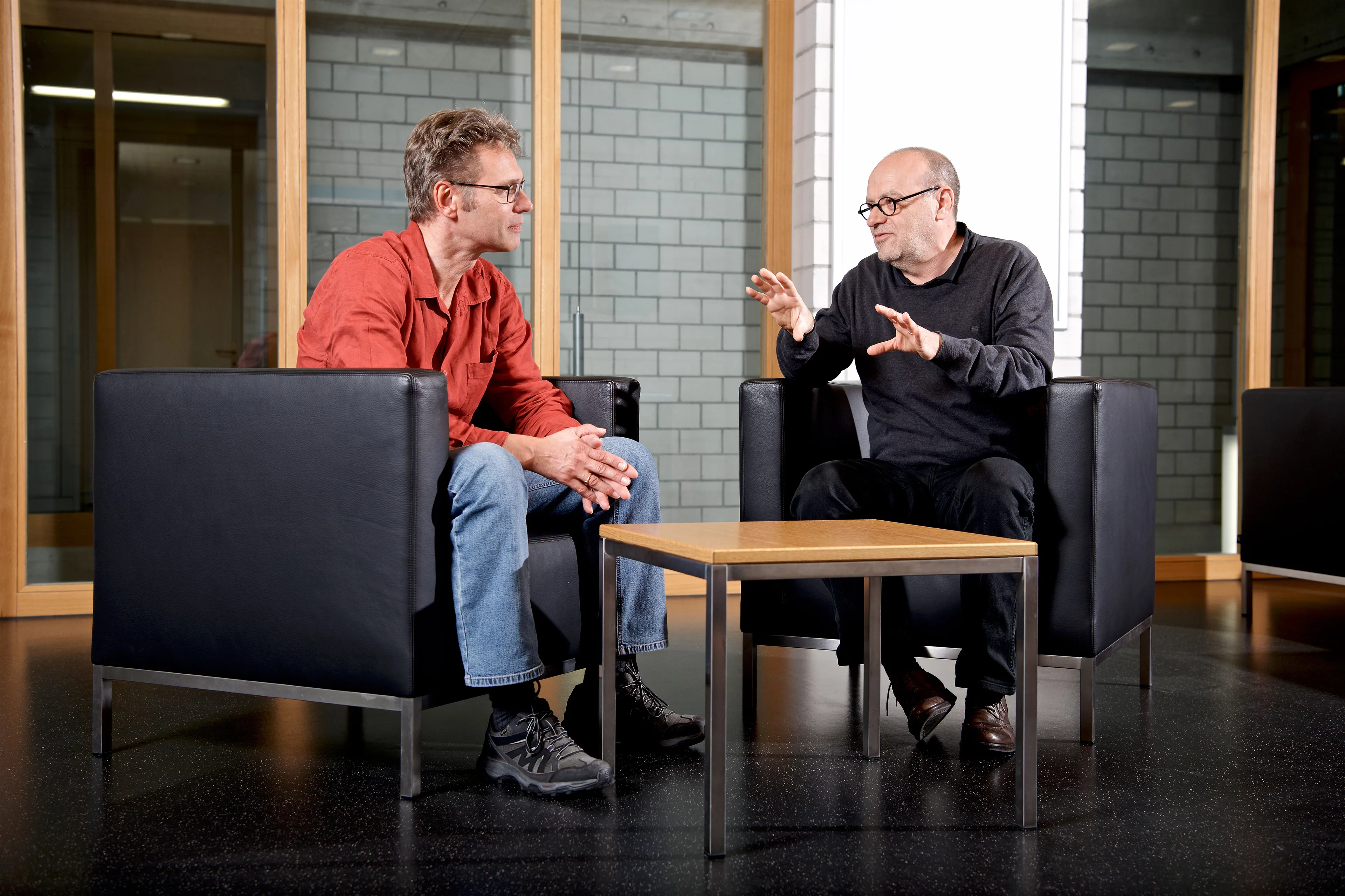With muons, materials under consideration for the electronics of the future can be investigated. In this interview, two PSI researchers, Alex Amato, head of the Laboratory for Muon Spin Spectroscopy, and Thomas Prokscha, head of the Low-Energy Muons Group, explain the special characteristics of these elementary particles.
Mr. Amato, Mr. Prokscha, why are muons so significant for you and your research colleagues? And how can it be that hardly any layperson knows about these particles?
Alex Amato: Muons are elementary particles – actually just like electrons, but 200 times heavier. You can definitely call muons exotic particles, since they are not found in atoms and thus are not part of the matter that surrounds us. But muons are constantly raining down on us out of the upper atmosphere. There, they are created when protons from outer space hit the atoms of the outer layer of the atmosphere. Muons are very short-lived, though, which means that soon after their creation they decay again into other particles.
In the research at PSI, we artificially generate muons by making protons from our local proton acceleration facility strike a piece of carbon. When the protons hit the atomic nuclei of the carbon, muons are generated. These muons fly out of the carbon and, concentrated into a beam, can be used for our research.
How do you apply this muon beam?
Thomas Prokscha: At PSI we have a total of six instruments for experiments to investigate materials with muons, all of which belong to Alex's Laboratory for Muon Spin Spectroscopy. At the instrument where my group and I work with low-energy muons, we can analyse very well what happens at the interfaces between two materials. We developed the technology for that ourselves here at PSI, and since 2006 we have made it available to the international research community. Up to today, no one else in the world can do it at a level approaching this quality. We have roughly 10,000 low-energy muons per second that we can shoot at the sample – that is, at the object to be examined. Low-energy means that the muons are slowed down beforehand. Unfortunately, that is accompanied by a loss of muons, meaning that we start with 500 million muons per second at the muon source SμS (pronounced "ess mew ess" - editor's note). But we want low-energy muons because we can precisely determine, through the selection of their energy, to what depth in the material they will penetrate. If we choose the energy in such a way that the muons stop at the boundary layer in the sample, we can probe this interface.
Why are you so interested in interfaces?
Amato: At the interfaces of two suitable materials, you can get completely different and new properties in comparison to the ones of the separate materials. Also, this is where the phenomena that are exploited nowadays in electronics take place. Hardly anyone assumes that already tomorrow the quantum computer will replace today's electronics. So researchers and developers are still searching for materials that continue to use present-day principles of electronics but at the same time are better than what is currently on the market. We ourselves do not aim to develop the electronics of the future. Our goal is to understand the fundamentals and make our contribution along this path.
Could you explain in a bit more detail why you use muons?
Prokscha: It is precisely the ephemeral nature of the muons that we are exploiting. When we have implanted them in our sample's interface, they decay there into other particles. In doing so, each muon emits, among other decay products, a so-called positron, which we record in detectors.
Amato: Many of our experiments deal with the magnetic properties of materials. The positron created in the decay of the muon doesn't fly away from it in just any direction but rather indicates, through the angle of its trajectory, how the local magnetic fields are oriented at the site in the sample that the positron came from. We measure the angle at which the positrons fly out by positioning positron detectors all around the sample.
Prokscha: Now we can slightly vary the energy of the incoming muons. As a result they stick either a bit farther up or farther down in the sample. Thus we can gradually measure, in a targeted way, the magnetic properties surrounding the interface. Finally, we can vary the temperature as well, and here too determine dependencies and correlations.
It’s surely a challenge to keep the six muon instruments in operation, Mr. Amato?
Amato: Oh yes. In my laboratory we are a comparatively small team of around 20 people, nearly half of whom are physicists with permanent positions. It works because we are all highly motivated and enjoy what we are doing. But all of us also have several jobs: The equipment always needs to be refined; we have to take care of the external users when they are making their measurements so that they will get good results, because new users have no time to learn the procedure; and then we also have our own experiments. All that is a constant balancing act for us.
Interview: Paul Scherrer Institute/Laura Hennemann

